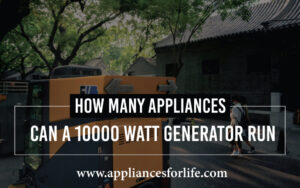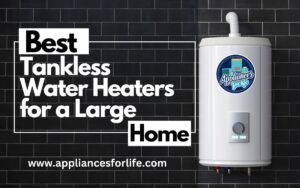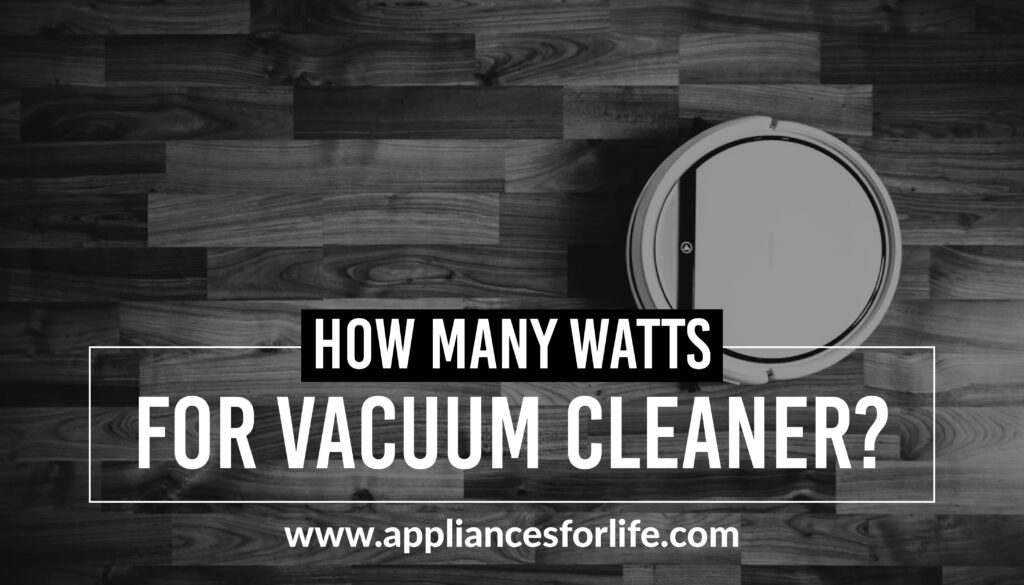- The invention of the vacuum cleaner has indeed come a long way in its advancement and sophistication. From a heavy and loud appliance, entirely difficult to maneuver, to a sleek, handy, and quiet appliance, competely easy to control, they have come a long way. The ease and ergonomics now built into vacuum cleaners make them extremely suitable for many use cases. For instance, you can use your vacuum cleaner to remove a pet’s fur and even clean the deepest corners of your air conditioner.
- While your vacuum cleaner has now become a magic wand at your beck and call, it may not speak so well of your monthly expenditure if you wave this wand too often. Frequent use of your vacuum cleaner may result in excessive consumption of energy/power. But how will you even know how much power your vacuum cleaner consumes if you don’t understand the reading and calculations of wattage and suction powers as units of measuring a vacuum cleaner’s power consumption? Find out more in this article.
A vacuum cleaner, sometimes called a vacuum, is a device that uses suction to remove dirt from floors, upholstery, draperies, and other surfaces. A vacuum cleaner is an incredible innovation that has made cleaning significantly easier and enjoyable in the home. With a properly working vacuum cleaner, you need not worry about the time and pain it may cost you to clean your floors or cars- you only need to investigate how to clean your car using the vacuum. A vacuum cleaner is also quite efficient at picking the smallest grime and dirt. Apart from cleaning your floors, a vacuum cleaner can tend to your Air Conditioners, upholsteries, and draperies, and it does this effectively well.
Table of Contents
Toggle
Just like other electrical appliances, vacuum cleaners use a certain level of power and electricity to carry out an effective suction. It is important to understand the wattage specifications of a vacuum cleaner to put it to good use and also be able to calculate how much energy is going into vacuuming, just as every prudent owner would be encouraged.
A vacuum cleaner using suction power to deep clean your rugs is quite easy to use. All you need to do to invoke its incredible abilities is turn it on and hover it over the surface you intend to clean. It is important to know that this technology has not always been so sophisticated- the absolute ease it brings to cleaning your floorings and your pet’s furs has not always been the case; the vacuum cleaner invention started with manual vacuums, invented in 1860- It gathered dust with a rotating brush and had a bellows for generating suction, this vacuum was not exactly ergonomic or easy to use; it was excessively heavy and loud, to say the least.
Understandably, we’ve come a long way from manual vacuum cleaning to using vacuum cleaners with cords. Still, regardless of this leap in technological advancement, there is no doubt that traditional vacuum cleaning was riddled with a lot of discomfort and hassles. Following the difficulty that ‘heavy vacuuming’ posed, there was a need to introduce some ease and effectiveness to vacuum cleaning, and ‘viola,’ we have cordless vacuum cleaners. The best vacuum cleaners are so versatile that they can handle different flooring, reach every corner of your closet because they’re easy to maneuver, and leave your upholsteries spotless because of their impressive suction ability. Hence, the best vacuum cleaners offer impressive ergonomic and cleaning abilities for air conditioners and other surfaces.
What is the best suction power for a vacuum cleaner?
We are going to address the topic of this article by first assessing what the best suction power for a vacuum cleaner is because, The suction power of a vacuum cleaner is one of the best ways to measure its efficiency and ability to suck dirt, dust, mold and other pollutants in your house. High suction power is essential if you wish to clean dust and debris from carpets, sofas, and under the bed. Hence, this adds that a vacuum cleaner with low-intensity suction can get rid of the dirt on the top layer of your rug, but it may not be able to carry out an effective deep cleaning/vacuuming. Let us look at some of the measures of suction power for vacuum cleaners.
Airspeed
One effective way to determine a vacuum cleaner’s suction power is the speed at which air is sucked into its hose. Usually, this speed is measured in the following units; mph (miles per hour), kmph (kilometers per hour), or MPS (meters per second).
It is important to know the airspeed of your vacuum cleaner as its airspeed does not only understand its suction power. It also helps you determine the cleaning capacity of your vacuum cleaner. The cleaning capacity of a vacuum cleaner is a function of its suction power simply because the better it sucks, the better it also cleans. A high airspeed may be essential to the excellent cleaning performance of a vacuum cleaning performance. Still, I must warn you that it may also require a stronger motor/engine, which automatically translates into more energy consumption. However, the good thing is; Manufacturers sometimes add different attachment tools for cleaning, which increases the overall efficiency of a vacuum without increasing its airspeed.
Airflow measured in CFM
Another way to determine a vacuum cleaner’s suction power is through airflow. The airflow of a vacuum cleaner is often measured in ft3/m (cubic feet per minute), m3/m (cubic meters per minute), or L/s (liters per second), with the correlation between all three units being as such:
One cubic foot = 0.0283 cubic meters = 28.3 cubic liters.
In very simple terms, the Airflow of a vacuum cleaner is the measurement of its entire volume, and volume is simply the totality of length, breadth, and height of air sucked in by the vacuum cleaner. It denotes the airflow power from the surface the vacuum cleaner is operating on to the bin.
However, it is important to draw your attention to the fact that manufacturers of vacuum cleaners do not use the airflow measurement indicator, despite that it accounts for one of the few accurate ways to measure the suction power of a vacuum cleaner.
This measurement considers the motor power and the exhaust system’s resistance and thus offers an accurate suction power. The higher the value of CFM, the higher the vacuum cleaner’s suction power will be. More importantly, another important point to note about airflow is that the value mentioned on the vacuum cleaner’s specifications is often without consideration of any additional accessories, so the actual suction power might be lower than what is claimed by the manufacturer.
Air Watts or Output power
Air wattage is another way to measure the suction power of a vacuum cleaner, and air wattage itself is the amount of power a vacuum cleaner requires per unit airflow through the vacuum’s nozzle. Many manufacturers print the value of air wattage on their vacuum cleaner as a way of suction power indication. Still, if you don’t find it on your vacuum cleaner, you can get your air wattage value by running some calculations on your sealed suction value and the CFM value.
The formula: Air wattage = Sealed suction (inches of H2O) x Airflow (CFM) x 0.117254
A canister vacuum cleaner should have 220 AW, and an upright vacuum cleaner should have 200 AW for better efficiency. Premium brands such as Dyson and Shark have upright vacuums that produce 270 AW, which is the top of the air watts range. Also, vacuum cleaners with HEPA filters need to have greater air wattage as the air needs to be pulled through tiny holes, which requires more power.
Water Lift
The water lift is also called sealed suction and is used to determine a vacuum cleaner’s suction power. To get this water lift measurement, a tube is filled with water and placed in a sealed container. Hence the vacuum cleaner’s suction power is directly proportional to the water level in the tube. However, the tube must be connected to the vacuum cleaner and turned on. As soon as this is done, the vacuum begins to suck the water. The higher the water level rises, the better the vacuum cleaner’s suction power.
It is essential to know that vacuum cleaners are not exactly made for this procedure. Hence, some of them also have a mechanism to shut down the power in such a case to avoid overheating the motor.
Watts Motor Power
The wattage unit is the best way to describe the capacity of a home appliance. Sometimes, people even liken the wattage of a vacuum cleaner to its suction capacity, but this is not how it works in most cases; there are several other components in a vacuum cleaner that consume power. So a 1200-watt vacuum cleaner may only use 400 watts for suction.
The motor power of a vacuum cleaner only describes how much electrical power the vacuum will need to work and not the actual efficiency of the vacuum cleaner. Industrial and commercial vacuum cleaners have a wattage of 1000-4000, and the home use vacuum cleaner has a wattage of 1000-1600.
How many watts does a vacuum cleaner use
While the vacuum cleaner is not the household appliance that consumes the most electricity, it is still used regularly in almost every home. Using a vacuum cleaner to do housework will certainly affect your home electricity bill. However, not all vacuum cleaners consume the same amount of electricity. It is, therefore, essential to know how much energy vacuum cleaners consume before purchasing. This article will discuss that and other important things about vacuum power.
As stated originally, a vacuum cleaner uses an air pump to collect dirt and dust from dirty surfaces, and this process is made possible through a process called suction. Vacuum cleaners are found in varying models and sizes. Most household vacuum cleaners range between 500 and 3000 watts, while the most economical and popular models use around 1400 watts. However, in actual fact, most energy-efficient vacuum cleaners consume around 600 to 800 watts of power. Hence, using your vacuum cleaner 2 hours per week may cost at least 83 cents per month.
It is not so difficult to tell the specific wattage your vacuum cleaner operates on; after all, it is printed boldly on the vacuum cleaner’s label or its user’s manual. Now, as explained originally, the energy consumption of a vacuum cleaner depends on the capacity of its motor and of course, the frequency of its use. Therefore, to know the annual energy consumption of your vacuum cleaner, you can use this formula:
Number of hours of using x Number of days of use x (Appliance power (in Watts)/1000) = Number kWh
For instance, for a vacuum cleaner with a power of 800 W, used 1 hour per week and 52 days per year: 1 x 52 x (800/1000) = 41.6 kWh;
Furthermore, to ascertain the cost of your vacuum cleaner’s consumption per year, you only need to use the formula below;
Price per kWh x Consumption (in Watts) = Annual consumption
The wattage of a vacuum cleaner is not necessarily the most important parameter in determining the caapacity of a vacuum cleaner. Still, it is certainly essential to determine the suction quality of your vacuum cleaner. The wattage of a vacuum cleaner says something about that vacuum’s cleaning capacity and suction ability. It is primarily an indicator of how much electricity is being used. How the vacuum cleaner is designed is particularly important concerning cleaning performance. If the vacuum cleaner nozzles are perfectly matched to the device and have an aerodynamic shape, dust, lint, or hair will be sucked up and disappear even at a lower wattage.
In the following example, we can see the watt power of a vacuum cleaner and what it can do:
350 W – suction power sufficient for dry cleaning linoleum, parquet, tiles, and other smooth surfaces. If you don’t have carpets and don’t plan on cleaning upholstered furniture, an inexpensive, low-power vacuum cleaner will do;
400 W – suction power that allows you to successfully clean the carpet and cope with a large amount of dust and wool if there are animals in the house;
450 W or more – suction power sufficient for cleaning carpets, long-pile coverings, and upholstered furniture. The most convenient option is a vacuum cleaner with a suction power regulator.
FAQs
How much power does my vacuum cleaner use?
It is important to know how much energy your vacuum cleaner consumes- not only will you be able to plan your expenses by so doing, but you will also be able to determine how effective your cleaning would be, especially when you assess the later in the light of other factors like suction power. To figure out how much power you consume, look for the wattage on the appliance label. Then, estimate how much time you spend vacuuming by day, week, or month. Then, multiply time spent by wattage and divide by 1,000 to get the kilowatt hours you’re using, and there it is, you have your answer.
Do less-powerful vacuums mean less-effective cleaning?
Vacuum cleaners that use less power can be just as effective as high-wattage machines. The design of the motor, the kind of filter, and the overall design of the hose and cleaner heads affect cleaning effectiveness. For instance, a power nozzle puts extra power in the cleaner head, dramatically increasing its cleaning efficiency. But if the cleaning ability of your vacuum is not as decent as expected, you may need to get a repair appliance kit and look into it.
16 MINUTES
ESTIMATED TIME DESIGNING AND UPLOADING THIS ARTICLE
9 HOURS
ESTIMATED TIME RESEARCHING AND WRITING THIS ARTICLE
You Might Also Like

Brown Stove Works Inc., a leading appliance manufacturer in the United States, is the maker of brown electric stoves. The best electric stoves for your kitchen will rank highly based on price, performance, and features. The oven is equipped with three racks and heats evenly

Top 5 Most Amazing 48-inch Ductless Range Hoods
In our 48” ductless range hood review, we’ll be exploring the best 48-inch ductless range hoods available on the market today. Top 5 48-inch Ductless Range Hood Comparison Table As impressive as cooking it, you can’t afford to do it in an unsafe environment

The Best Crosley 12000 BTU For Your Room
Since their innovation, air conditioners have helped us artificially the temperature of our environment. They become our most valuable asset, especially during summer when the weather is rather hot. Air conditioners serve the desired purpose only when they fit into the space where we want

Top 3 Best Crosley Professional Refrigerators
You won’t know how good Crosley refrigerators are until you invest in one. If you’re considering getting a Crosley professional refrigerator, our review of the best Crosley professional refrigerators will help you make the best decision. Getting a good refrigerator is a big deal, and

5 Best Dishwasher Detergent For Sparkling Dishes
Dishwashers do a remarkable job, getting your dishes cleaned up but they can not succeed without a solution of hot water and detergent and a pressurized spray action. Dishwashers have a special detergents designated for dishwashing, such that if any regular/random dishwaher is used, it

How to Fix a Dent in a Refrigerator Door
The refrigerator is one of the most-used kitchen appliances and like every other appliance, it is prone to damages, big or small. In this article, we’ll be discussing how to fix a dent in a refrigerator door using different effective methods. In this article, we’ll

How Many Appliances Can A 10000-watt Generator Run
We live under the shadow of global warming. There has been an upsurge in natural disasters that have caused power outages for several days. A 10,000-watt generator will give you enough juice to run large appliances, various tools on a job site, or many RV

State of the Art Electric Stoves For Sale
Electric stoves today offer the consumer the chance to cook on a sleek and stylish stove at an affordable price while still being kind to the environment. They are safe and simply the best type of stove to use. If you are upgrading your kitchen

Top 5 Best Tankless Water Heaters for a Large Home
Some appliances have become so important that they are no longer considered luxury items but necessities. The water heater is one of those necessary appliances for every household nationwide. They’re so important that a report from Energy Star reveals that 7-7.8 million units of these

HOW TO REMOVE STAINS FROM STAINLESS STEEL REFRIGERATOR
Having a stainless steel refrigerator is always nice. You have a super clean, simple and elegant finish that is widely regarded as the best in the market. Its shining looks, however, comes at a price. To maintain your stainless steel refrigerator’s elegant finish, you need


